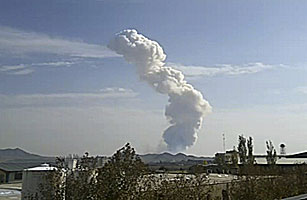
Was Israel Behind a Deadly Explosion at an Iranian Missile Base?
Time

The powerful blast or series of blasts — reports described an initial explosion followed by a much larger one — devastated a missile base in the gritty urban sprawl to the west of the Iranian capital. The base housed Shahab missiles, which, at their longest range, can reach Israel. Last week’s report from the International Atomic Energy Agency (IAEA) said Iran had experimented with removing the conventional warhead on the Shahab-3 and replacing it with one that would hold a nuclear device. Iran says the explosion was an accident that came while troops were transferring ammunition out of the depot “toward the appropriate site.” (See why ties between the U.S. and Iran are under threat.)
The explosion killed at least 17 people, including Major General Hassan Moqqadam, described by Iranian state media as a pioneer in Iranian missile development and the Revolutionary Guard commander in charge of “ensuring self-sufficiency” in armaments, a challenging task in light of international sanctions.
Coming the weekend after the release of the unusually critical IAEA report, which laid out page upon page of evidence that Iran is moving toward a nuclear weapon, the blast naturally sharpened concern over Israel’s threat to launch airstrikes on Iran’s nuclear facilities. Half the stories on the Tehran Times website on Sunday referenced the possibility of a military strike, most warning of dire repercussions.
But the incident also argued, maybe even augured, against an outright strike. If Israel — perhaps in concert with Washington and other allies — can continue to inflict damage to the Iranian nuclear effort through covert actions, the need diminishes for overt, incendiary moves like air strikes. The Stuxnet computer worm bollixed Iran’s centrifuges for months, wreaking havoc on the crucial process of uranium enrichment.
And in Sunday’s editions, the Hebrew press coyly listed what Yedioth Ahronoth called “Iran’s Mysterious Mishaps.” The tallies ran from the November 2007 explosion at a missile base south of Tehran to the October 2010 blast at a Shahab facility in southwestern Iran, to the assassinations of three Iranian scientists working in the nuclear program — two last year and one in July. (See photos of the semiofficial view of Iran.)
At the very least, the list burnishes the mystique of the Mossad, Israel’s overseas spy agency. Whatever the case-by-case reality, the popular notion that, through the Mossad, Israel knows everything and can reach anywhere is one of the most valuable assets available to a state whose entire doctrine of defense can be summed up in the word deterrence. But it doesn’t mean Israel is the only country with a foreign intelligence operation inside Iran. The most recent IAEA report included intelligence from 10 governments on details of the Iranian nuclear effort. And in previous interviews, Western security sources have indicated that U.S. and other Western intelligence agencies have partnered with Israel on covert operations inside Iran. Sometimes the partner brings specific expertise or access. In other cases, Iranian agents on the ground who might harbor misgivings about Israel are allowed to believe they are working only with another government altogether.
Saturday’s blast was so powerful it was felt 25 miles away in Tehran, and so loud that one nearby resident with combat experience thought he had just heard the detonation of an aerial bomb. “Frankly it did not sound like an arms depot from where I was because when one of those goes off, it is multiple explosions over minutes, even hours depending on the size of the facility,” the resident says. “All I heard was one big boom. I was sure from the quality of the noise that anyone in its immediate vicinity was dead. Something definitely happened, but I would not trust the [Revolutionary] Guards to be absolutely forthcoming as to what it was.”
Nov. 15, 2011
